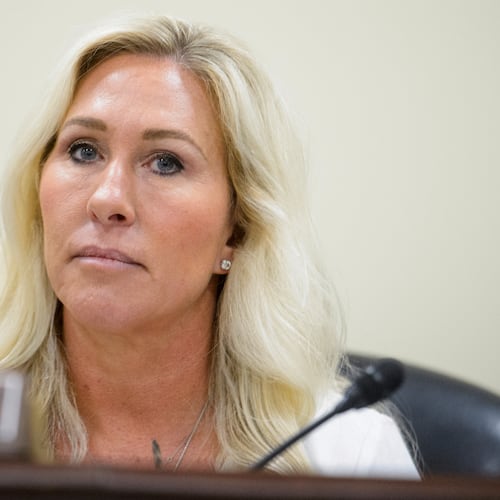With a swipe of his pen, Gov. Nathan Deal set in motion another phase of the effort to make criminal justice in Georgia less costly and more effective - this one focused on youthful offenders.
Deal signed House Bill 242, adding Georgia to the list of states making sweeping changes aimed at slowing the ballooning costs of incarceration while also steering petty offenders away from a life of crime.
Under the measure Georgia will lock up fewer juvenile offenders and send those accused of less serious crimes to community-based programs. It also will seek to address the root causes of minor offenses such as truancy, running away or being unruly.
The Legislature passed a similar bill dealing with adult offenders. Both measures enjoyed broad support, with fiscal conservatives worried about soaring costs allied with criminal justice reformers who think stringent sentencing hasn't worked. And both had Deal's backing.
“I knew the state could not continue on the path it was traveling in locking up people, throwing away the key and hoping for the best,” Deal said Thursday before the bill-signing at the Elbert Shaw Regional Youth Detention Center at Dalton.
He said the reforms in both the adult and juvenile systems are “the right thing to do. We think it will produce results we all want.”
Once the youth law takes effect Jan. 1, so-called “status offenders” arrested for minor offenses won’t go into the criminal justice system at all. Instead they will be sent to social services programs equipped to address the underlying reasons for their trouble, often found in their home lives. Teenagers accused of misdemeanors and low-level crimes like drug possession will not be sentenced to a juvenile prison. Instead they will be diverted to community-based programs.
Those who commit designated felonies will be separated into two categories. Crimes in which no one is hurt will mean no more than 18 months locked up plus another 1 1/2 years of intensive probation. Designated felons who harm someone could be locked up for as many as five years.
Other states that have made similar changes say they were able to close facilities because fewer kids were in the criminal justice system, saving taxpayers money.
Georgia taxpayers will save $85 million over five years and avoid building two more juvenile facilities, Deal said.
Advocates also expect a drop in the state’s 65 percent recidivism rate for juvenile offenders.
Forecasts show 640 fewer teenagers locked up in Department of Juvenile Justice facilities, saving $91,000 a year per bed.
Georgia currently has 1,820 juveniles in either a short-term regional youth detention centers or at a youth development campus, akin to a prison for adults.
“There is a national recognition that the recidivism rate for juvenile offenders is way too high for the money that we are spending,” said state Rep. Mary Margaret Oliver, D-Decatur, who was on the commission that produced the blueprint for the new law. “There also is growing recognition, on a national level, that incarceration of relatively low (risk), non-violent offenders is a waste of money.”
Advocates say money saved will go into expanding community-based programs now in place in only a few counties, such as Clayton and Newton.
Georgia has $6 million in state and federal dollars to spend on pilot programs. Last month month the Governor’s Office for Children and Families asked dozens of juvenile courts and local groups for proposals for community-level juvenile justice programs that address drug and alcohol abuse and dysfunctional families and offer group and individual therapy.
“If you do those things on the front-end of the system … you can reduce your recidivism rates, you can reduce this revolving door of these kids coming back into the youth system,” said Marc Levin, director of the politically-conservative think tank Right on Crime.
Right on Crime found significant savings for taxpayers in nine states that have made similar changes, along with declines in juvenile prison populations and crimes committed by teenagers, Levin said.
As in Georgia, savings for taxpayers was a key selling point to lawmakers and policy makers in the states that have already gone this route.
“We were just locking up too many kids and it was enormously expensive,” said Elizabeth Clarke, president of the Juvenile Justice Institute in Illinois. “The outcomes were alarming.”
Redeploy Illinois, with an annual budget of $3 million, is credited with dropping the number of juveniles in custody from 2,000 to 900 and making it possible to close two secure facilities.
Ohio, the first state to take such an approach with RECLAIM, has cut its juvenile inmate population from 2,600 to 550; consequently four facilities were closed.
New York City’s Close to Home program launched last September and officials expect to see a 62 percent decline in the number of kids the courts order locked up.
California credits its community-based programs for reducing the number of juveniles locked up from more than 10,000 in 1996 to 1,000. Last year, the state spent $93.4 million to defray the cost to counties for the program.
Even as Texas closed or consolidated seven facilities because the number of juveniles in custody had dropped by 62 percent, state officials also recorded a 27 percent decline in in juvenile crimes over four years,according to the Texas Public Policy Institute.
“Kids aren’t born criminals,” Levin said. “These kids are from homes where they were abused or not supervised. We need to get them while they are still malleable. If you can get that youth on the right track and they can become a successful citizen, it’s a huge advantage to us.”
About the Author
Keep Reading
The Latest
Featured


